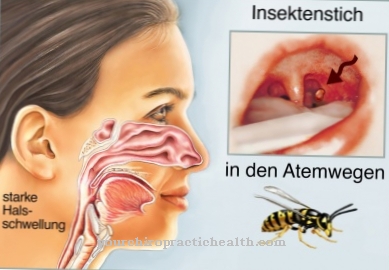As Trans fatty acids unsaturated fatty acids are mentioned which have at least one double bond in the trans configuration. While trans fatty acids occur naturally only in small amounts in ruminants, they arise in larger amounts mainly during fat hardening in the food industry. The consumption of trans fatty acids above a certain percentage leads to an increase in LDL cholesterol and a lowering of HDL cholesterol with all associated health risks such as arteriosclerosis and coronary heart disease.
What are trans fatty acids?
Saturated fatty acids are carboxylic acids with different lengths of - mostly unbranched - hydrocarbon chains. Their molecular formula is CnH2n + 1COOH. If there are one or more double bonds between two carbon atoms, it is a mono- or polyunsaturated fatty acid.
In the case of unsaturated fatty acids, there is a so-called cis-trans configuration isomerism. A cis or Z isomerism exists when the substituents on the two carbon atoms with double bonds are on the same side. In the case of trans or E isomerism, the two substituents are on opposite sides.
Although the chemical formula for both isomers does not change, the two forms differ significantly in their physical and biochemical properties. Their effect within the metabolism also differs considerably. Naturally occurring unsaturated fatty acids occur almost exclusively in the cis form.
Only in the rumen of ruminants do anaerobic bacteria produce unsaturated fatty acids in the trans configuration, so that the milk of ruminants and cheese made from them also contain small amounts of trans fatty acids. Natural vegetable fats and oils consist exclusively of fatty acids in the cis form, which is important for metabolism.
Trans fatty acids, also simply referred to as trans fats, are produced on a large scale during the industrial processing of food, especially when fat is hardened to achieve a certain consistency. In many fried potato products (French fries, chips), in ready meals and in certain industrially manufactured baked goods as well as in some nut and nougat creams, the proportion of trans fatty acids is alarmingly high.
Even at home, valuable cis vegetable oils can form harmful trans isomers if they are heated to over 130 degrees Celsius, as is the case when using polyunsaturated vegetable oils for frying.
Increased stroke risk as a result
It has been proven that trans fats have an impact on cholesterol metabolism. Trans fats in food lead to an increase in the proportion of LDL (low density lipoproteins) with a simultaneous reduction in the proportion of HDL (high density lipoproteins) within the total cholesterol fraction. Since cholesterol or cholesterol is essential for the structure of all cell membranes and for the synthesis of steroid hormones, but is also almost insoluble in water, it requires means of transport, the so-called lipoproteins.
In greatly simplifying the metabolic processes involved, the statement can be made that LDLs in the blood transport cholesterol to the membranes of the cells, while HDLs take over the return transport of unneeded cholesterol to the liver. As a result, LDL is colloquially referred to as "bad" and HDL as "good" cholesterol.
An imbalance in the ratio between HDL and LDL in favor of the LDL fraction leads to an excess of cholesterol in the membranes of the arterial blood vessels, especially in the coronary arteries, so that the formation of atherosclerosis is promoted. Triggered by arteriosclerotic changes in the arterial vessel walls, constrictions (stenoses) or even blockages of the arteries arise.
Conglomerates of erythrocytes (thrombi) can also form at the bottlenecks, which trigger a stroke if they are carried into the brain with the bloodstream and cause an arterial occlusion there. If the proportion of trans fats ingested exceeds one percent of the daily required energy intake as a source of energy, the risk of stroke and the risk of suffering from coronary heart disease increase dramatically.
Beware of hidden trans fats
In the United States, the health problems that the consumption of foods containing artificial trans fats can cause have already resulted in ramifications for the Food and Drug Administration (FDA). In the European countries there are still no uniform regulations that regulate the content of trans fats in food.
At the moment there are still a few national regulations, such as in Austria and Denmark, which limit the permissible proportion of trans fatty acids in certain foods. Corresponding EU directives, which have to be implemented by all EU countries, are in preparation. The topic has also been present in Europe since 1999, when the FDA published an extensive study into the content of trans fats in food.
The only indication that German consumers receive about the presence of trans fats in a certain product is the mandatory declaration “contains hydrogenated fats”. Ultimately, this means that there is still no target-oriented obligation to declare the proportion of trans fats in the products.
At present it can still be assumed that industrially manufactured finished products such as French fries, chips of all kinds, fast food products and some baked goods contain trans-fatty acids in alarming amounts. Whenever “hardened” or “partially hardened” fats play a role in the manufacture of the products, caution is required.
In the manufacture of finished products, the industry relies on “hardening” unsaturated fatty acids by hydrogenation using high temperatures of up to 200 degrees and pressure, or giving the fatty acids the desired and necessary consistency. The goal is to make saturated fatty acids from unsaturated fatty acids.
Because the process does not run completely, unsaturated fatty acids in trans configuration are also formed as undesirable by-products. For this reason, caution is generally advised when using artificially produced spreads and spreads.
Why an "oil change" makes sense
The trans fatty acids from industrial production are a problem because they are not classified as foreign by the body's metabolism. Instead, like the natural cis-fatty acids, they are processed further and incorporated into body substances without showing the expected metabolic reactions there.
The effect of trans fats on increasing the LDL concentration with a simultaneous reduction in the HDL fraction also gives reason to substitute foods that contain more than two percent trans fatty acids in their total fat content with foods with natural unsaturated fatty acids in the cis configuration, therefore to carry out an "oil change" in these cases.
It is very likely that in a few years' time there will be a rigorous restriction of the permitted proportion of trans fatty acids in food in the EU member states along the lines of the USA. A natural proportion of trans fatty acids occurs, for example, in dairy products from ruminants. It is almost exclusively conjugated linoleic acid, in which the two double bonds are always to be found on two adjacent carbon atoms.
There is controversial debate among experts as to whether conjugated linoleic acid, which always occurs in the trans configuration, has a positive health effect in contrast to artificial trans fats. Previous studies do not necessarily allow this conclusion, but so far no negative health effects have been proven.
Better to prepare it yourself
A safe alternative to ready-made meals, ready-made pizzas, and French fries, which are “blessed” with a good amount of trans fats, are self-prepared meals that should consist exclusively of natural ingredients. They not only protect against the unwanted consumption of trans fats with all the associated health risks, but also ensure a natural taste experience.
Consumption of animal products derived from ruminants contains conjugated linoleic acid, a naturally occurring unsaturated fatty acid in its trans version. According to the current state of knowledge, conjugated linoleic acid is not associated with health risks, but also shows no demonstrable positive effects.























.jpg)



